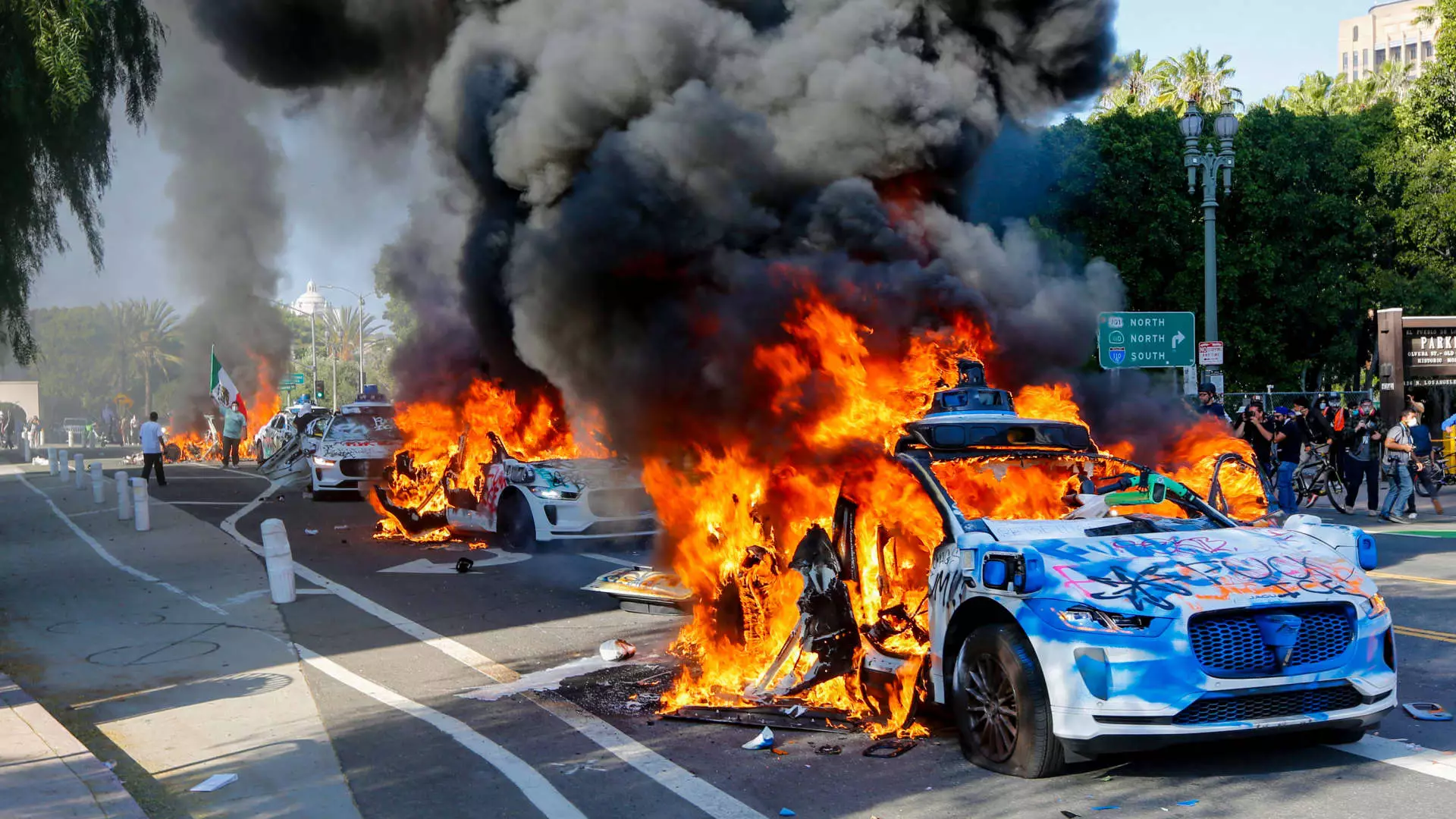In the heart of downtown Los Angeles, an unsettling scene unfolded as several Waymo autonomous vehicles became the unlikely symbols of rising discontent. Fire engulfed these vehicles amidst an outpouring of emotions related to President Donald Trump’s stringent immigration policies. This incident, which included not just the destruction of property but also protest against governmental action, highlights a simmering frustration within a community that feels threatened. The public discourse surrounding immigration has become increasingly toxic, drawing stark battle lines and giving rise to aggressive civil disobedience, showcasing that for many, the era of peaceful protest seems outdated.
The vandalism was facilitated by an amalgamation of anger and desperation. Activists were using whatever means were available to express their frustrations against the U.S. Immigration and Customs Enforcement (ICE) raids that had incited peaceful protests throughout the city. The burning Waymos illustrate not only the anger directed towards the Trump administration but also a cultural clash regarding the future of urban spaces. With an unsettling trend towards automation and surveillance, these vehicles, which were initially hailed as symbols of innovation and progress, were cast into the flames as symbols of a system perceived to be complicit in oppression.
A Symbolic Target for Protesters
The Waymo vehicles, remnants of technology that promise convenience and efficiency, became an emblem of governmental overreach—for many, they represented an intrusive presence just as unwelcome as the ICE agents they were protesting against. The fact that graffiti reading anti-ICE messages was scrawled across these autonomous vehicles speaks volumes about how intertwined technology and socio-political sentiments are at this juncture.
The act of setting fire to these vehicles was not merely an impulsive act of vandalism; it was a calculated statement that sent shockwaves through Silicon Valley and beyond. It illuminated how technology, while beneficial in many respects, can become a target for those unflinchingly opposed to the social injustices they feel are exacerbated by such advancements. The blend of technology in a realm of politics illustrates a complex web of dependency, distrust, and tension. For many, the autonomous vehicle represents a robotic embodiment of state power—one that perhaps furthers surveillance rather than promotes liberty.
The Fallout for Waymo and the Broader Implications
After the flames died down, Waymo’s decision to suspend services in protest-affected areas reveals the fragility of corporate operations within a rapidly changing socio-political landscape. Waymo is in an interesting position; it operates in a sphere that relies on public acceptance and trust—both of which can be eroded when external conditions become volatile. The company is walking a tightrope of maintaining operational integrity while navigating the socio-political currents that threaten to disrupt their very business model.
Further complicating this scenario is the brazen federal response. California Governor Gavin Newsom’s skate on legality as he threatens to fight back against the federal government’s heavy-handed tactics shows a growing chasm between state and federal levels of governance. The idea that the National Guard would be deployed to quell protests adds a layer of irony—protecting against what has been framed as a “threat” by the same government that is ostensibly meant to protect its citizens.
Long Shadow of Automation in the Fight for Justice
The current events in Los Angeles highlight more than just a clash of ideologies; they expose the chasm between human experience and technological progress. Waymo’s plans to drastically ramp up production and reach a milestone of 15,000 vehicles in operation by 2030 seem almost naive in light of this crisis. It raises questions about how much society is willing to accept automation when that very automation can become entangled in the broader sociopolitical fabric—often leading to civil unrest.
For those caught in the crossfire, the cries for justice seem inextricably linked to how a corporation navigates its role in a politically incendiary environment. It’s a wake-up call that highlights not only the need for compassion but also for a sincere understanding of the implications of deploying technology in communities rife with unrest. As we stand at this crossroad, the question looms larger than life: can social justice and technological advancement truly coexist without conflict?


Leave a Reply